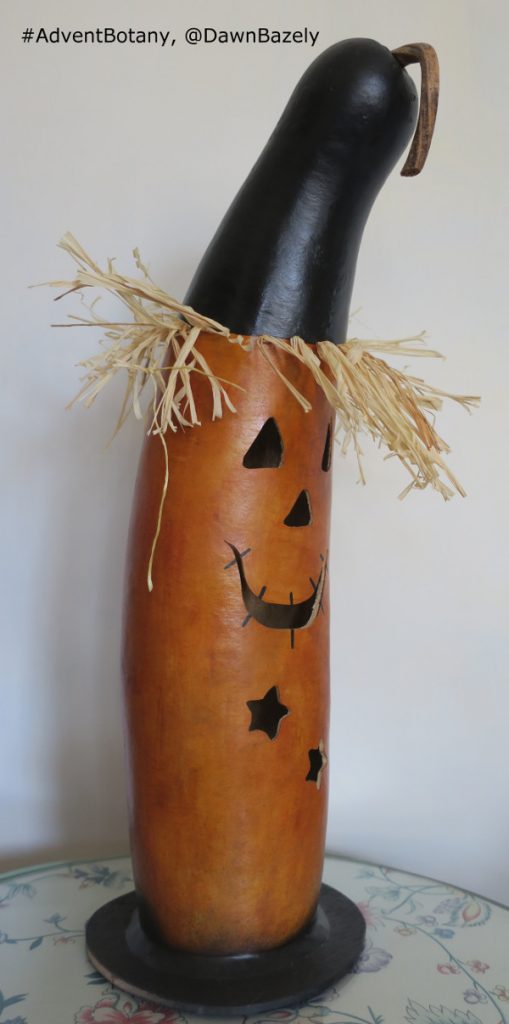By Dawn Bazely
Prince Albert, who moved to England from Germany, to marry the young Queen Victoria, led the Victorians in inventing much of today’s Christmas aesthetic that dominates Britain and North America. But, the Nativity is celebrated by diverse cultures throughout the world, and is much more than O Tannenbaum, and The Holly and the Ivy.
Many different local plants play important roles in Christmas traditions, and Alastair and Jonathan’s Advent Botany series has taught me a lot about them, along with the more traditional Middle Eastern, European and North American species that I regularly associate with my Christmas season.
Today, I’m inspired by the gift from a friend of a Peruvian fair trade ornament that is made from a hard gourd. The Cucurbitaceae or gourd family, includes important foods such as pumpkin, squash, melons and cucumber. Alastair’s yodelling gherkin from Day 1 of the 2016 Advent Botany series belongs to this family, whose members were amongst the earliest plant species cultivated by humans.
While members of the gourd family are important food plants around the world, they play an especially important role in indigenous cultures of the Americas. The Wikipedia article on Cucurbita tells us:
“Along with maize and beans, squash has been depicted in the art work of the native peoples of the Americas for at least 2,000 years.”
When I looked into it, I discovered that my Christmas nativity ornament is not made from a squash or pumpkin gourd from the genus Cucurbita, but from the hardshell gourd, Lagenaria siceraria. These gourds have many uses, and Martha Stewart has a great video that shows how to turn them into vases and bowls.
Gourds are most popular at Hallowe’en. This year, my Biology student daughter, Carrie, carved a scary science pumpkin (Cucurbita pepo). That’s a cholesterol molecule!
Although they aren’t in common use at Hallowe’en, I keep a hardshell gourd painted like a traditional pumpkin ornament, for the years when I don’t have someone like Carrie on hand to carve a cholesterol molecule pumpkin for me!
Many Torontonians grow different kinds of squash in our gardens. Wikipedia tells me that “Squash is the common name and can refer to any member of the genus Cucurbita”. In Canada, we distinguish between summer and winter squash cultivars, based on the thickness of the fruit skin, so zucchini or courgette is a summer squash, while butternut squash is a winter squash.
Carrie was home from university when I was writing this post, and explained that summer squash is the example of dominant epistasis given in her Genetics textbook. Epistasis describes how genes, rather than alleles interact. Cucurbita pepo come in many different shapes and colours. In dominant epistasis, the presence of the dominant allele of one gene masks any expression of either the dominant or recessive allele of the second gene. Globerson (1969) explained how this works in squash, in the paper, “The inheritance of white fruit and stem color in summer squash Cucurbita pepo L.”
The 12:3:1 ratio of phenotypes for fruit colour in squash is explained below:
“Color is recessive to no color (white) at one allelic pair. This recessive allele must be expressed before the specific color allele at a second locus is expressed. At the first gene white colored squash is dominant to colored squash, and the gene symbols are W=white and w=colored. At the second gene yellow is dominant to green, and the symbols used are G=yellow, g=green.
If the dihybrid is selfed, three phenotypes are produced in a 12:3:1 ratio. The presence of the dominant W allele masks the effects of either the G or g allele, making this type of interaction dominant epistasis. The following table explains how this ratio is obtained.”
| Genotype | Fruit Color | Gene Actions |
| 9 W_G_ | White | Dominant white allele negates effect of G allele |
| 3 W_gg | White | Dominant white allele negates effect of G allele |
| 3 wwG_ | Yellow | Recessive color allele allows yellow allele expression |
| 1 wwgg | Green | Recessive color allele allows green allele expression |
Editors note: when visiting a local garden centre I discovered that gourds not only make novel Christmas decorations; you can also buy gourds converted to solar powered fairy homes. Who needs a bird box when you can have colonies of fairies in the garden?
References and Resources:
Globerson, D. 1969. Euphytica (1969) 18:249. doi:10.1007/BF00035697
Dominant epistasis: https://www.ndsu.edu/pubweb/~mcclean/plsc431/mendel/mendel6.htm
The American Gourd Society fact sheets: http://www.americangourdsociety.org/FAQ/types/chart.html
http://www.americangourdsociety.org/FAQ/fall.html
Missouri Botanical Gardens fact sheet on gourds: http://bit.ly/2gMZva8
How to make bowls from hard, dried gourds. A Martha Stewart video: http://www.marthastewart.com/913014/how-make-bowls-dried-gourds






Pingback: Advent Botany 2016 – Day 19: Christmas Gourds — Culham Research Group « Herbology Manchester
Pingback: Daughter of #adventbotany 2016 | Dr M Goes Wild
Pingback: #AdventBotany 2018, Day 18: Advent VLOG | Culham Research Group
Pingback: A VLOG to celebrate the 5th birthday of the #AdventBotany blog series | Bazely Biology lab: collaborative, interdisciplinary, fun